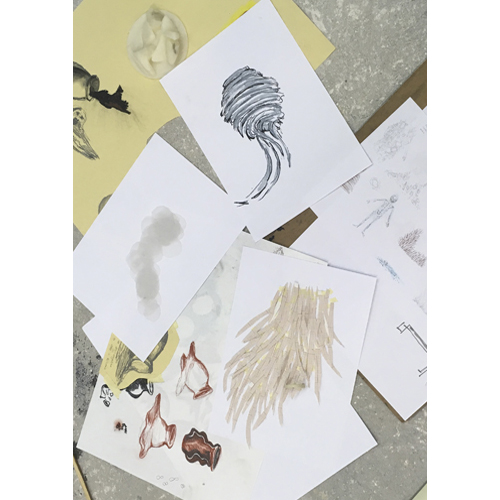RELIGAR

RESIDÊNCIA ARTÍSTICA: DESLOCAÇÕES #02
MAY 4 MAI 26
“Religar” is the title of the second edition of the artistic residence “Deslocações”, a collaboration between the Abade Pedrosa Municipal Museum/International Museum of Contemporary Sculpture and the Faculty of Fine Arts from Universidade do Porto. In this edition the students of the Sculptural Practice subject were challenged to choose an artifact with a spiritual character from the Abade Pedrosa archaeological collection, to make a sculpture project in connection with its formal, symbolic and contextual characteristics. This focus on the archaeological traces aims to direct our attention to an archaic world of inexhaustible knowledge which escapes from the everyday emergencies, creating an act of self-deciphering on the subject, because when we place ourselves before an artifact and its historical charge we receive a wider sense of Self.
Everything has started for us already too
Any magical, sacred or spiritual artifact has a plural genetic nature: it makes a set of formal characteristics collide with a wide and discontinuous intentionality inside a system of belief in which are present sacrifice, festivities, trances, funerary and initiation rites, prayers, music, among others. It is difficult to assess the essence of this kind of object if we disregard its origin or context. A dislocation it’s always mandatory. For this second edition of the artistic residence – “Deslocações” or “Dislocations” – the students were challenged to choose an artifact with a spiritual character from the Abade Pedrosa archaeological collection to start an intensive process of study aiming the production of a sculpture able to establish a dialogue with the chosen artifact. Its main goal was to construct a dialogue, an intimate conversation between shapes, thicknesses, colors, scales, weights, symbols, matters, ideas. It was just a matter of building a relationship. We were warned even before we started (and now we can confirm it) of the problem of this task: any chosen archaeological trace can never be considered only as a window to other time more or less immemorial ignoring its most potent and spectacular ability of unexpectedly giving us back our own reflection. A ruin is both a window and a mirror. This awareness allowed each student, in their multiple visits to the objects, to enter into them, not the objects but literally into themselves, in a process of self-deciphering.
When we regard the objects and their historical charge we receive a wider sense of Self, deep and lucid. Looking into a sacred artifact disregarding its primordial situation or hiding before it our own desires is naïve or even perverted. In this residence, being already aware and vigilant we wanted to bring with us two main concerns.
1st – recognize that in the most archaic roots we can find the less-fatuous fire;
2nd – start in this initial fire a search for ourselves, “to escape through the centuries to the mechanics of the present; to come to my own thoughts”.
Therefore with weekly meetings in the past couple of months, each student made a path of intimate experiences with small sized drawings or sculptures beginning a restless and wishful circumspection about and from the chosen object to reach the results now present in this exhibition. Each path has produced a dialogue, an alternation of timeless voices (discourses) that relate to this immeasurably indecipherable “binding void”.
Samuel J M Silva




